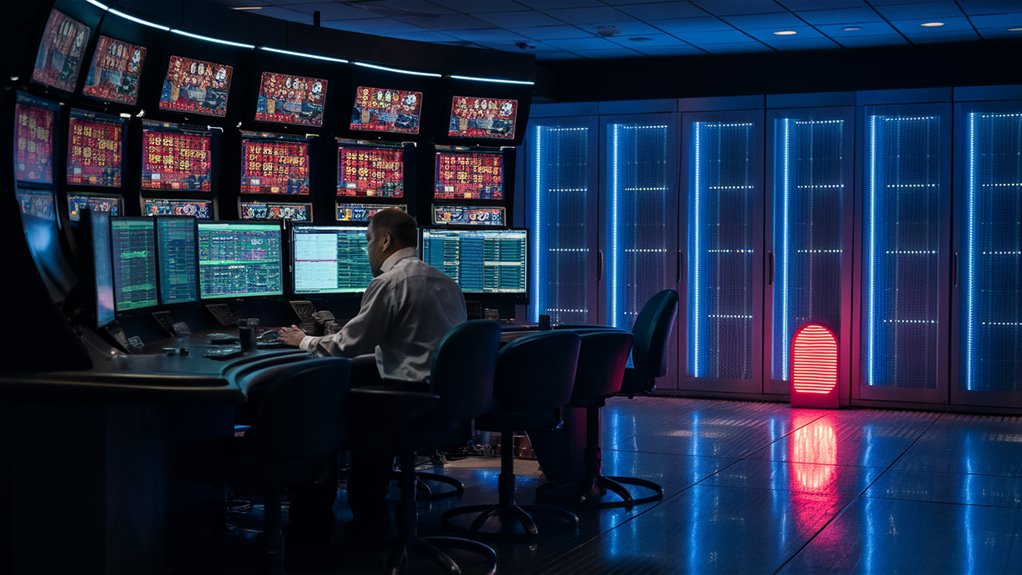Casino Security: Keeping Player Info Safe Today

Strong Guard Layers
New casino security uses many shield layers to keep player data safe over linked game systems. At its heart, a all-day Security Center (SOC) checks over 100,000 details per tick, using hard trust plans and Security Info and Event Checks (SIEM) to see all threats well.
Guarding Players
Top player guard mixes a few safety steps:
- AES-256 code for data send
- Bio checks
- AI-powered watch
These techs work together to fight off sly net threats (APTs) and smart info steal tries.
Rules to Follow & Marks
Casino data safety sticks to tight rules including:
- Card Pay Info Safety Mark (PCI DSS)
- Gaming Labs World (GLI) marks
- ISO 27001 okay
People Part & Learning
The cybersafe world is more than tech answers:
- Keeps teaching staff on safety
- Programs to know social tricks
- Often checks on security
These steps build a full guard against new web risks in today’s game places.
Know New Casino Net Risks
How Casino Cybercrime Has Grown
Today’s casino cyber dangers have grown from simple slot tricks to huge web attacks.
Bad actors now aim at key casino parts with hard attack ways, including:
- Player track setups
- Pay ways
- Watch net parts
- Sly net threats (APTs)
- Zero-day cracks
Main Casino Net Attack Kinds
Stealing Info
Casino data grab tries to pull out key info including:
- Player personal details
- Money notes
- Own game tricks
- Work info
Ransomware Hits
Casino ransom tasks aim at key systems to:
- Lock key databases
- Block entry to game places
- Mess up money tasks
- Push for money
Work Mess-ups
Casino work attacks try to:
- Hurt game truth
- Turn off safety
- Cut money flow
- Harm how folks see the brand
IoT Guard Weak Spots
Smart casino tech shows big safety tests through:
- RFID chip gaps
- Digital card read tricks
- Auto bet system fails
- Net-linked game tools
New Gaming Threats
New casino attack ways keep growing with:
- Cloud game spots
- Mobile bet apps
- Third-party works links
- API guard holes
- Code trick weak spots
Many Checks for Who Gets In
Many Checks for Who Gets In at Casinos
Main Check Parts
Multi-check systems are key to today’s casino safety plan, giving needed shields against unasked entry and smart ID attacks.
Strong check plans cut the danger of stolen pass and stop takeovers in high-stake game spots.
Mixing Check Factors
The best safety setups mix three main check factors:
- Know-based checks (words, PINs)
- Things you can hold (smart cards, phones)
- Bio checks (finger marks, face ID)
For more safety in risky pay, top systems add place checks and how you act checks as extra guard steps.
How the System and Danger Checks Work
Alone layer work keeps the system safe while still letting checks mix well. This layout makes sure that if one part is hit, it doesn’t hurt other safety steps.
Changing check ways change check needs based on how risky a thing is, putting in place harder controls for big cash outs or odd betting acts.
Checks All the Time
Always checking who gets in is key to stop breaks.
By always watching bad check tries and odd get-in tries, systems can spot likely threats before they turn into big safety events, keeping both player info and casino pots safe.
Code Tech for Player Safety
Key Code Tech for Player Safety in Online Play
Top Code Rules for Casino Safety Today
Code techs build the main guard for player safety in today’s digital casino world.
Three key systems work together to make a guard 안전놀이터 that can’t be beat: same side code, two-side code, and code that checks while still locked.
Code for Data Now Through Same Side Code
AES-256 code is at the front of data safety now, giving strong safety during live play times.
This strong same side code way keeps player deals and get-in safe with not much hit on how fast it works, making sure info stays locked against unasked looks.
Safe Talks with Two-side Code
RSA and ECC ways are top marks for safe data sends between casino parts and player tools.
These two-side code systems make alone public-private key mixes, making a wall that no one can get through against talk cuts and keeping all deals very clean.
New Code to Check Data
Code tech that checks while locked changes how safe data work goes in the game field.
This new win lets deep looks at locked player info without opening it, cutting the chance of being hit during data work while keeping tight to rules and letting smart checks of how players act.
Rule Following and Safety Marks
Casino Rule Following and Safety Marks

Needed Safety Plans and Rules
Modern casinos work under hard rule needs that shape their safety steps a lot.
PCI DSS rule following is a needed thing, watching how card info and money acts are dealt with in casino work.
Rule Eyes and Safety Needs
Gaming Control Board and Money Crimes Watch Net (FinCEN) rules set up base safety moves including:
- Act watching systems
- Odd act report plans
- Full check papers
- Many ID checks
- Eye on big money acts
Info Safety Marks and Okay
ISO 27001 in Place
The ISO 27001 plan needs full info safety control setups within digital casino spots. This world mark needs:
- Orderly safety steps
- Risk checks
- Keep getting better
- Paper control
- Oft security checks
Gaming Labs World (GLI) Rule Following
GLI marks watch over key casino work including:
- Random number making truth
- Player data safety moves
- Game system safety
- Deal check ways
- Get-in control systems
Not sticking to these rules can lead to big bad things, like losing your permit, having to pay a lot of money, and a big hit to how folks see the gaming field.
Watching and Threat Checks All the Time
Watching and Threat Checks All the Time in Casino Safety
Watching Things Well Together
Watching all the time across many safety layers is key to modern casino threat checks.
AI-driven watch systems look at how players act, odd deal acts, and safety breaks all at once.
Fast answer systems react to threats within seconds, making a never-seen-before level of guard and cutting the time when you are weak.
Bio and How You Act Checks
Mixing face ID tech with how you act checks makes a strong guard way.
Machine learning ways follow how you bet and move, letting us see likely cheats and edge players before they can hurt how things run.
Modern casino safety setups check more than 100,000 points per tick across the play floor, making sure they see everything.
Work Checks and Event Management
A top Security Center (SOC) watches net flow, database get-ins, and staff acts all the time.
Advanced SIEM answers put events from many safety parts together, making the system act right away on big risk events.
This many-layered safety plan works well to fight off dangers from outside and weaknesses from inside while keeping to hard rules and doing things well.
Teaching Staff and Who Gets In Control
Full Casino Safety: Teaching Staff and Who Gets In
Plans to Teach Staff Well
Casino safety good stuff starts with strong staff teaching jobs.
Full safety programs must have deep lessons on:
- How to keep data safe
- What to do if trouble comes
- Knowing social tricks
- Sticking to safety rules
These parts make a people-based shield against possible safety breaks.
Putting in Strong Get-In Control
Many Checks for Who Gets In
Role-based clearances are key to making get-in work well.
Putting in hard trust plans needs:
- Bio checks
- Smart card checks
- Changing PIN setups with 24-hour change
- Watching who gets in all the time
Watching and Rule Following
Advanced watching systems keep an eye on all get-in tries through:
- Auto warning plans
- Pattern see software
- Get-in log checks
- Watching all the time
Making Sure Rules Are Followed
What Staff Need to Do
What happens if rules are broken sets up clear results for trouble, while orderly steps make sure:
- Quick end of get-ins for staff who leave
- Tight secret deals
- Oft security checks
- Rule checks often
Checking Safety of the System
Testing for weak spots finds and fixes:
- System weak spots
- Get-in control fails
- Possible safety gaps
- Inside threat moves
Act Plan for Data Trouble in Casino Spots
Seeing Trouble Early and Watching
Auto watching setups start the work of keeping data safe in casino places.
Quick see plans always look for odd data acts and unasked get-in tries, letting fast acts if trouble comes.
Putting in quick warning setups with machine learning helps see trouble early much better.
Who Acts When Trouble Comes
A set team for data trouble needs smart picking, including:
- IT safety experts
- Law rule helpers
- Talk pros
- Stay in Control
- Digital check pros
- Data safety heads
Putting Plans to Work and Testing Them
Act plans must make clear what level the trouble is with steps to act.
Testing trouble plans check if they work and if the team is ready.
Keeping good files makes sure all acts are tracked right and stick to the rules.
What to Do Right Away When Trouble Hits
Quick Acts
- Steps to keep trouble small
- Keeping proof safe
- Setting apart systems
- Checking data saves
How to Talk About It
- Telling all who need to know
- What the rules need you to tell
- Handling talks well
- How we talk inside
Fixing and Stopping Future Trouble
- What we need to write down
- Looking into what went wrong
- Putting systems back
- Steps to stop more trouble
- Looking back at what happened
How We Check If We Did Well
Checking how we did must line up with work marks and rule needs.
Updating plans makes sure we keep up with new threats and rule needs.
Keeping good files makes sure we have safe, full data of all that happened and talks about it.
